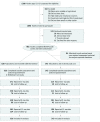Effect of Computer-Based Substance Use Screening and Brief Behavioral Counseling vs Usual Care for Youths in Pediatric Primary Care: A Pilot Randomized Clinical Trial
- PMID: 31225897
- PMCID: PMC6593643
- DOI: 10.1001/jamanetworkopen.2019.6258
Effect of Computer-Based Substance Use Screening and Brief Behavioral Counseling vs Usual Care for Youths in Pediatric Primary Care: A Pilot Randomized Clinical Trial
Abstract
Importance: Annual preventive health visits provide an opportunity to screen youths for unhealthy substance use and intervene before serious harm results.
Objectives: To assess the feasibility and acceptability and estimate the efficacy of a primary care computer-facilitated screening and practitioner-delivered brief intervention (CSBI) system compared with usual care (UC) for youth substance use and associated risk of riding with an impaired driver.
Design, setting, and participants: An intent-to-treat pilot randomized clinical trial compared CSBI with UC among 965 youths aged 12 to 18 years at 5 pediatric primary care offices and 54 practitioners. Patients were randomized to CSBI (n = 628) or usual care (n = 243) groups within practitioner with 12 months of follow-up. Data were collected from February 1, 2015, to December 31, 2017. Data analysis was performed January 1, 2018, to March 30, 2019.
Interventions: Patients self-administered a computer-facilitated substance use screening questionnaire before their annual preventive health visits. Immediately after completing the screening, they received their score and level of risk and viewed 10 pages of scientific information and true-life vignettes illustrating health risks associated with substance use. Trained practitioners received the screening results, patients' risk levels, talking points designed to prompt brief counseling, and recommended follow-up plans.
Main outcomes and measures: Feasibility and acceptability were assessed using adolescents' postvisit ratings. Days of alcohol use, cannabis use, and heavy episodic drinking were assessed at baseline and 3-, 6-, 9-, and 12-month follow-ups using Timeline Followback, and riding in the past 3 months with a driver who was impaired by use of alcohol or other drugs was assessed using 2 self-report items. The primary outcome was the intervention effect among at-risk youths who reported using alcohol or other drugs in the past 12 months or riding with an impaired driver in the past 3 months at baseline. The secondary outcome was the prevention effect among those with no prior use or risk.
Results: Among 871 youths screened, 869 completed the baseline assessment; 211 of the 869 reported alcohol or cannabis use in the past 12 months at baseline (mean [SD] age, 16.4 [1.3] years; 114 [54.1%] female; 105 [49.8%] non-Hispanic white). Of the 211 youths, 148 (70.1%) were assigned to the CSBI group and 63 (29.9%) were assigned to the UC group. Among youths in the CSBI group, 105 (70.9%) reported receiving counseling about alcohol, 122 (82.4%) reported receiving counseling about cannabis, and 129 (87.2%) reported receiving counseling about not riding with an impaired driver. Adjusted hazard ratios for time to first postvisit use of alcohol or other drugs for CSBI vs UC were as follows: alcohol use, 0.69 (95% CI, 0.47-1.02); heavy episodic drinking, 0.66 (95% CI, 0.40-1.10); and cannabis use, 0.62 (95% CI, 0.41-0.94). At 12-month follow-ups among 99 youths who reported having ridden in the past 3 months at baseline with an impaired driver (64 in the CSBI group; 35 in the UC group), adjusted relative risk ratio of riding in the past 3 months with an impaired driver for CSBI vs UC groups was 0.58 (95% CI, 0.37-0.91). No intervention effect was observed among youths who reported no prior use of alcohol or other drugs (n = 658) or not having ridden with an impaired driver (n = 769) at baseline.
Conclusions and relevance: The CSBI system is a feasible and acceptable option for screening youths in primary care practice for use of alcohol and other drugs and for risk of riding with an impaired driver, and the estimated efficacy in this sample warrants further testing in larger samples.
Trial registration: ClinicalTrials.gov identifier: NCT00227877.
Conflict of interest statement
Figures


References
-
- Johnston LD, Miech RA, O’Malley PM, Bachman JG, Schulenberg JE, Patrick ME. Monitoring the Future: National Survey Results on Drug Use 1975-2017: 2017 Overview: Key Findings on Adolescent Drug Use. Ann Arbor: Institute for Social Research, University of Michigan; 2018.
-
- National Institute on Alcohol Abuse and Alcoholism Alcohol Screening and Brief Intervention for Youth: A Practitioner’s Guide. Washington, DC: National Institutes of Health, Department of Health and Human Services; 2011.
-
- National Center for Health Statistics Health, United States, 2016: With Chartbook on Long-term Trends in Health. Hyattsville, MD: National Center for Health Statistics; 2017. - PubMed
-
- Harris SK, Woods ER, Sherritt L, et al. . A youth-provider connectedness measure for use in clinical intervention studies. J Adolesc Health. 2009;44(2)(suppl):S35-S36. doi:10.1016/j.jadohealth.2008.10.099 - DOI
Publication types
MeSH terms
Associated data
LinkOut - more resources
Full Text Sources
Medical
Miscellaneous

